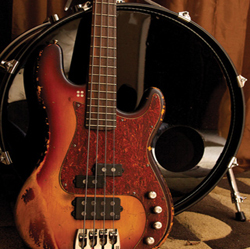
A common mistake is to emphasize the kick with either too much level or EQ and not enough on the bass guitar. This gives you the illusion that your mix is bottom light, because what you’re doing is effectively shortening the duration of the low frequency envelope in your mix.
Since the kick tends to be more transitory than the bass guitar, this gives you the idea that the low frequency content of your mix is inconsistent. For pop music, it’s best to have the kick provide the percussive nature of the bottom while the bass fills out the sustain and musical parts.
3. Make sure the snare is strong, otherwise the song will lose its drive when everything else is added in. This usually calls for at least some compression. You may need a boost at 1 kHz for attack, 120 Hz to 240 Hz for fullness, and 10 kHz for snap.
As you bring in the other drums and cymbals, you might want to dip a little of 1k on these to make room for the snare. Also make sure that the toms aren’t too boomy (if so, try rolling them off a bit below 60 Hz first before you begin to EQ elsewhere).
4. If you’re having trouble with the mix because it’s sounding cloudy and muddy on the bottom end, turn the kick drum and bass off to determine what else might be in the way in the low end. You might not realize that there are some frequencies in the mix that aren’t musically necessary.
With piano or guitar, you’re mainly looking for the mids and top end to cut through, while any low-end might be just getting in the way of the kick and bass, so it’s best to clear some of that out with a high-pass filter. When soloed the instrument might sound too thin, but with the rest of the mix the bass will sound so much better, and you won’t really be missing that low end from the other instruments.
Now the mix will sound louder, clearer, and fuller. Be careful not to cut too much low end from the other instruments, as you might loose the warmth of the mix.
5. For dance music, be aware of kick drum to bass melody dissonance. The bass line is very important and needs to work very well with the kick drum when it’s reproduced over the huge sound systems commonly found in today’s clubs.
If your kick has a center frequency of an A note at around 50 Hz or 60 Hz and the bass line is tuned to A#, they’re going to clash. Tune your kick samples to the bass lines (or vice versa) where needed.
6. If you feel that you don’t have enough bass or kick, boost the level, not the EQ. This is a mistake that everyone makes when they’re first getting their mixing chops together.
Most bass drums and bass guitars have plenty of low end and don’t need much more, so be sure that their level together and with the rest of the mix is correct before you go adding EQ. Even then, a little goes a long way.
Bobby Owsinski is an author, producer, music industry veteran and technical consultant who has written numerous books covering all aspects of audio recording. For more information be sure to check out his website and blog. Go here to check out The Mixing Engineer’s Handbook.
